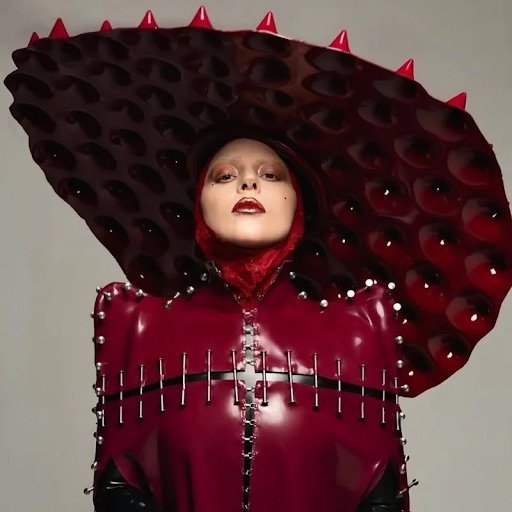Her rise to fame in 2009–2010 was unlike anything the world had seen. As one of the first pop stars to harness the power of the internet, she seemed to exist in a nonstop flurry of TMZ photos and gossip blogs. Their appetite for her was insatiable. She cycled through so many looks and sounds in just three years that one critic described her as “speed-running Madonna’s entire career.”
As her fame grew, so did the absurdity of the headlines. Rumors swirled that she had staged a satanic ritual in a London hotel, that she was secretly a hermaphrodite, or that she planned to saw off her own leg “for fashion.”
Then came the infamous 2010 MTV Awards, where she wore a dress made entirely of meat. Few seemed to understand the joke—she was presenting herself as literal fodder for the tabloids, there to be consumed.
On stage, she was an idol to her fans, the Little Monsters. But anyone who isn’t a megalomaniac knows that kind of worship is an illusion.
“I’m alone, Brandon. Every night,” she told her stylist in the 2017 documentary Five Foot Two. “I go from everyone touching me all day and talking at me all day to total silence.”
Now 38 and happily engaged to tech entrepreneur Michael Polansky, Gaga admits those years of solitude frightened her.
“I think my biggest fear was doing this by myself—doing life on my own,” she tells the BBC. “And the greatest gift has been meeting my partner, Michael, and being in the mayhem with him.”
The couple has been together since 2020, announcing their engagement at the Venice Film Festival last September. That night, Gaga wore her million-dollar engagement ring in public for the first time—a dazzling oval-cut diamond set on an 18-karat white and rose gold pavé band.
But on her other hand, she wears something much simpler: a smaller ring containing blades of grass set in resin.
“Michael actually proposed to me with these blades of grass,” she reveals.
“A long time ago, we were in the backyard, and he asked me, ‘If I ever proposed to you, how should I do it?’ And I just said, ‘Just get a blade of grass from the backyard and wrap it around my finger. That would make me so happy.'”
It was a deeply romantic gesture, tinged with sadness. That same backyard in Malibu had once hosted the wedding of her close friend Sonja Durham, shortly before she passed away from cancer in 2017.
“There was so much loss, but this happy thing was happening for me,” Gaga says, recalling the moment Polansky proposed. “Getting engaged at 38… I was thinking about everything it took to get to this moment.”
A Love Story in Song
Those emotions found their way into a song on her new album, Mayhem.
Naturally titled Blade of Grass, the track features Gaga singing about “a lovers’ kiss in a garden made of thorns” and finding love in the midst of darkness.
She calls it a “thank you” to her fiancé. And in a way, fans might have a reason to thank him, too.
Mayhem marks Gaga’s full-force return to pop after years spent focusing on film, jazz collaborations, and the American songbook.
In a Vogue interview last year, she revealed that Polansky had encouraged her to go back to her roots.
“He was like, ‘Babe. I love you. You need to make pop music,’” she recalled.
“On the Chromatica tour, I saw a fire in her,” Polansky added. “I wanted to help her keep that alive and just make music that made her happy.”
The Return of Pop Gaga
With that mindset, Mayhem harks back to the high-energy, high-drama sound of early hits like Poker Face, Just Dance, and Born This Way.
On the latest single, Abracadabra, she even revisits the “roma-ma-ma” gibberish from Bad Romance—but this time, with a darker twist, singing: “morta-ooh-Gaga.”
The album artwork features her face reflected in a shattered mirror. In the music videos, she confronts earlier versions of herself.
It all builds to a climax on Perfect Celebrity, where she declares, “I became a notorious being”—a lyric that, much like her infamous meat dress, strips away her humanity.
“That’s probably the angriest song about fame I’ve ever written,” she says.
“I had created this public persona that I was fully becoming. Holding the duality of that—knowing where I begin and where Lady Gaga ends—was really a challenge. It kind of took me down.”
Finding Balance
How did she reconcile the public and private sides of her life?
“I realized it’s healthier to not have a dividing line, but to integrate those two things into one whole human being,” she says.
“The healthiest thing for me was owning that I’m a female artist, and that living an artistic life was my choice.
“I love songwriting. I love making music, rehearsing, choreography, stage production, costumes, lighting, putting on a show.
“That’s what it means to be Lady Gaga. I’m the artist behind it all.”
In past interviews, she has spoken about dissociating from her stage persona—believing that “Lady Gaga” was responsible for her success, while she, Stefani Germanotta, had contributed nothing.
But with Mayhem, she’s reclaiming her artistry—not just from her alter ego, but from producers and executives who, in the past, tried to take credit for her sound and image.
“When I was younger, people tried to take credit for my sound or my image,” she says.
“But all of my references, all of my imagination for what pop music could be, came from me.
“So I wanted to revisit my inspirations and my career and own it as my invention, once and for all.”
Bringing the Fans Along
From the start, it was clear she was excited about this new chapter.
Last summer, after performing at the Olympics opening ceremony, she took to the streets of Paris and played early demos of her new music for fans outside her hotel.
It was an impulsive decision, but also a throwback to her early days.
“I’ve done this for almost 20 years—playing my music for fans way before it comes out,” she says.
“After my shows, I used to invite fans backstage, and we’d hang out, and I’d play them demos to see what they thought.
“After 20 years, you don’t expect people to still show up and be excited to hear your music. So I wanted to share it with them, because I was just as excited that they were there.”
Closing the Chapter on Mayhem
For me, this is a full-circle moment. I first interviewed Lady Gaga in 2009, when Just Dance hit number one in the UK.
Back then, she was overflowing with excitement, calling herself a “heroin addict” for English tea and promising to email me an unreleased song, Blueberry Kisses—which, brilliantly, was about performing a sex act while smelling of blueberry-flavored coffee.
Over the years, I watched her interviews become more guarded. She’d wear elaborate costumes or jet-black sunglasses, deliberately placing a barrier between herself and the world.
But the Gaga I meet today is the same one I spoke to 16 years ago—comfortable in her skin, brimming with enthusiasm.
She credits that ease to “growing up and living a full life.”
“Being there for my friends, my family, meeting my amazing fiancé—all of these things made me whole, instead of my stage persona being the most important thing.”
With a sense of finality, she adds:
“I wanted Mayhem to have an ending. I wanted the chaos to stop.
“I stepped away from the icon. It ends with love.”











































